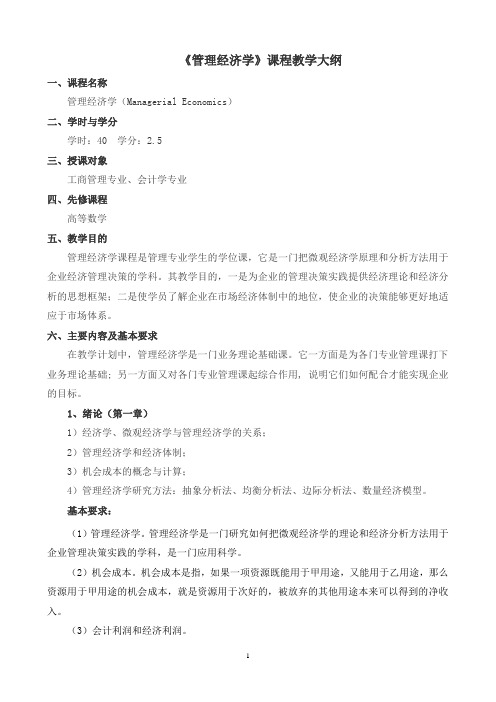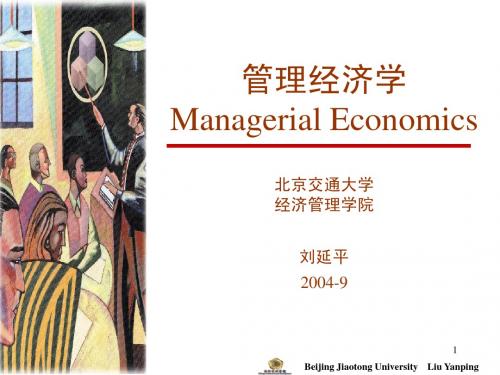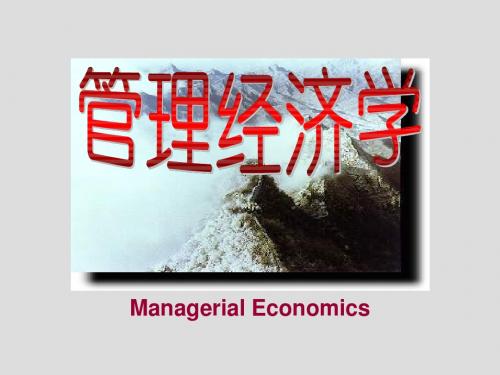管理经济学ManagerialEconomics
- 格式:ppt
- 大小:181.00 KB
- 文档页数:68

《管理经济学》课程教学大纲一、课程名称管理经济学(Managerial Economics)二、学时与学分学时:40 学分:2.5三、授课对象工商管理专业、会计学专业四、先修课程高等数学五、教学目的管理经济学课程是管理专业学生的学位课,它是一门把微观经济学原理和分析方法用于企业经济管理决策的学科。
其教学目的,一是为企业的管理决策实践提供经济理论和经济分析的思想框架;二是使学员了解企业在市场经济体制中的地位,使企业的决策能够更好地适应于市场体系。
六、主要内容及基本要求在教学计划中,管理经济学是一门业务理论基础课。
它一方面是为各门专业管理课打下业务理论基础; 另一方面又对各门专业管理课起综合作用, 说明它们如何配合才能实现企业的目标。
1、绪论(第一章)1)经济学、微观经济学与管理经济学的关系;2)管理经济学和经济体制;3)机会成本的概念与计算;4)管理经济学研究方法:抽象分析法、均衡分析法、边际分析法、数量经济模型。
基本要求:(1)管理经济学。
管理经济学是一门研究如何把微观经济学的理论和经济分析方法用于企业管理决策实践的学科,是一门应用科学。
(2)机会成本。
机会成本是指,如果一项资源既能用于甲用途,又能用于乙用途,那么资源用于甲用途的机会成本,就是资源用于次好的,被放弃的其他用途本来可以得到的净收入。
(3)会计利润和经济利润。
会计利润=销售收入-会计成本经济利润=销售收入-机会成本=销售收入-机会成本-正常利润(4)边际分析法和边际效用递减规律。
边际效用递减规律是指,在一定时期内,消费达到一定水平后,消费者消费某一商品的边际效用随着数量的增加而减少。
学习建议:自主学习和视频课堂3学时,练习1学时。
作业:1、一台设备可用来生产A产品,也可用来生产B产品,但是若生产其中一种,就必须放弃另一种。
与两种产品生产有关的一个计划期的数据如下。
(1)生产A、B两种产品的会计利润为多少?(2)生产A、B两种产品的经济利润为多少?2、某企业今年计划使用钢材10万吨,仓库里面有前年购入的钢材3万吨,单价为1200元/吨;有去年购入的钢材5万吨,单价为1500元/吨;还有今年购入的钢材5万吨,单价为1600元/吨。





《管理经济学》教学大纲一、课程名称:管理经济学英文名称:Managerial Economics课程编号:二、总学时:36学时三、学分数:2学分四、课程内容简介管理经济学是公共管理专业的基础课程,其所涉及的对象是管理决策。
在各类组织的管理活动中,组织管理者需要了解与掌握各种决策的经济后果。
管理经济学主要以微观经济学的基本理论为基础,借助于决策科学的、数理统计学等学科的各种方法和工具,指导企业决策者高效率地配置稀缺资源,制定和实施能使企业目标得以实现的经济决策。
管理经济学自诞生以来,被国内外越来越多的商学院和管理学院采用为核心必修课程,表明了它在培养造就高水平经济管理人才过程中不可替代的重要作用。
作为一门基础课程,管理经济学以讨论经济学的基本原理为主,如需求-供给分析、消费者效用分析、生产要素投入分析、竞争与垄断分析等,但同时也强调如何将这些原理应用于实际管理决策问题,如企业的价格策略。
五、教材周勤主编:《管理经济学》,石油工业出版社出版2003.9.六、教学目的通过本课程的学习,要达到以下目的:1.掌握经济学的基本概念与基本原理;2.掌握经济分析的主要方法;3.能够熟练使用经济学的原理及方法分析各种政策及管理决策。
七、教学方法本课程采用讲授、讨论、作业、模拟练习活动等多种教学形式,并采用多媒体辅助教学手段,以使学习者在参与教学过程中,掌握相关理论知识,通过作业练习等活动,形成和初步掌握在现代市场经济和政府宏观调控条件下,进行企业管理和公共事业管理分析的能力。
八、考试方式按照《山东大学公共管理硕士(MPA)研究生考试管理办法》的规定,采取闭卷考试,百分制,60分为通过。
课程总成绩(满分100分)由试卷卷面考试成绩、出勤与课堂互动参与成绩、作业成绩等三部分组成。
其中试卷卷面成绩、出勤与课堂互动参与成绩、作业成绩分别占该课总成绩的70%、20%、10%。
其中,试卷按70分(满分)命题,试卷卷面成绩、出勤与课堂互动参与成绩、作业成绩及课程总成绩均由任课教师评定。
PEKING UNIVERSITYHSBC BUSINESS SCHOOLProfessor KONG YingCourse OutlineManagerial EconomicsCOURSE DESCRIPTIONManagerial Economics is the application of economic theory and methodology to managerial decision making problems within various organizational settings such as a firm or a government agency. The emphasis in this course will be on demand analysis and estimation, production and cost analysis under different market conditions, advanced topics in business strategy. Students taking this course are expected to have had some exposure to economics and be comfortable with basic algebra. Some knowledge of calculus would also be helpful.COURSE OBJECTIVEIn today's dynamic economic environment, effective managerial decision making requires timely and efficient use of information. The purpose of this course is to provide students with a basic understanding of the economic theory and analytical tools that can be used in decision making problems. Students who successfully complete the course will have a good understanding of economic concepts and tools that have direct managerial applications. The course will sharpen their analytical skills through integrating their knowledge of the economic theory with decision making techniques. Students will learn to use economic models to isolate the relevant elements of a managerial problem, identify their relationships, and formulate them into a managerial model to which decision making tools can be applied. Among the topics covered in the course are: price determination in alternative market structures, demand theory, production and cost functions, and business strategy. In addition, the course will provide a basic introduction to econometric analysis and its role in managerial decision making.TEXBOOKS AND CLASS NOTESThe main textbook is Managerial Economics and Business Strategy, 7th ed. by Michael Baye, McGraw HillClass notes (PPT) and other materials will be posted online for students download.COURSE EVELUATIONMidterm Exam: 30%Final Exam: 50% Consulting Projects: 20%SYLLABUSAll chapters listed below refer to the Baye textbook unless otherwise indicated. You are responsible for materials in the Baye text that correspond to the material covered in class. The Baye text should be viewed as a learning aide, NOT as an independent source of examinable material. However, doing questions end of each chapters will greatly help you to prepare exams.Week 1The Fundamentals of Managerial Economics Ch 1Market Forces: Demand and Supply Ch 2Week 2Quantitative Demand Analysis Ch 3The Theory of Individual Behavior Ch 4Week 3The Production Process and Costs Ch 5Week 4The Organization of the Firm Ch 6The Nature of Industry Ch 7Week 5Midterm ExamManaging in Competitive, Monopolistic,Monopolistically Competitive Market Ch 8Week 6Basic Oligopoly Models Ch 9Game Theory: Inside Oligopoly Ch 10Week 7Pricing Strategies for Firms with Market Power Ch 11Week 8The Economics of Information Ch 12Advanced Topics in Business Strategy Ch 13Week 9A Manager’s Guide to Government in the Marketplace Ch 14Project Presentation and Hand InFinal Exam (TBD)CONSULTING PROJECTSIn order to help students to build up the managerial economics analysis skill we provide 4 real world consulting projects in the course. Students are required to independently conduct 4 consulting reports regarding to the 4 projects. The exercises require you to apply some of the tools you learned in each chapter covered in the class to make a recommendation based on an actual business scenario. The topics of 4 consulting projects are,·Estimating Industry Demand for Fresh Market Carrots·Estimation and Analysis of Demand for Fast Food Meals·Production Decisions at Harding Silicon Enterprises, Inc.·Pricing and Production Decisions at PoolVac, Inc.Cheating, Plagiarism and Free RiderThe penalties for any form of cheating or plagiarism (whether in exams or project) are severe. Written work submitted must be your own. Any sources of information used in completing your work must be identified. Plagiarized written work will not be accepted and you should be aware that non acceptance of a submission might, in some cases, lead to failure in the course. Since the project is a team work, the final report should identify each student’s contribution. The significant uneven contribution in the work will lead to less mark for the student who made less contribution comparing to his/her team member.。
《管理经济学》课程教学大纲一、课程名称管理经济学(Managerial Economics)二、学时与学分学时:40 学分:2.5三、授课对象工商管理专业、会计学专业四、先修课程高等数学五、教学目的管理经济学课程是管理专业学生的学位课,它是一门把微观经济学原理和分析方法用于企业经济管理决策的学科。
其教学目的,一是为企业的管理决策实践提供经济理论和经济分析的思想框架;二是使学员了解企业在市场经济体制中的地位,使企业的决策能够更好地适应于市场体系。
六、主要内容及基本要求在教学计划中,管理经济学是一门业务理论基础课。
它一方面是为各门专业管理课打下业务理论基础; 另一方面又对各门专业管理课起综合作用, 说明它们如何配合才能实现企业的目标。
1、绪论(第一章)1)经济学、微观经济学与管理经济学的关系;2)管理经济学和经济体制;3)机会成本的概念与计算;4)管理经济学研究方法:抽象分析法、均衡分析法、边际分析法、数量经济模型。
基本要求:(1)管理经济学。
管理经济学是一门研究如何把微观经济学的理论和经济分析方法用于企业管理决策实践的学科,是一门应用科学。
(2)机会成本。
机会成本是指,如果一项资源既能用于甲用途,又能用于乙用途,那么资源用于甲用途的机会成本,就是资源用于次好的,被放弃的其他用途本来可以得到的净收入。
(3)会计利润和经济利润。
会计利润=销售收入-会计成本经济利润=销售收入-机会成本=销售收入-机会成本-正常利润(4)边际分析法和边际效用递减规律。
边际效用递减规律是指,在一定时期内,消费达到一定水平后,消费者消费某一商品的边际效用随着数量的增加而减少。
学习建议:自主学习和视频课堂3学时,练习1学时。
作业:1、一台设备可用来生产A产品,也可用来生产B产品,但是若生产其中一种,就必须放弃另一种。
与两种产品生产有关的一个计划期的数据如下。
(1)生产A、B两种产品的会计利润为多少?(2)生产A、B两种产品的经济利润为多少?2、某企业今年计划使用钢材10万吨,仓库里面有前年购入的钢材3万吨,单价为1200元/吨;有去年购入的钢材5万吨,单价为1500元/吨;还有今年购入的钢材5万吨,单价为1600元/吨。